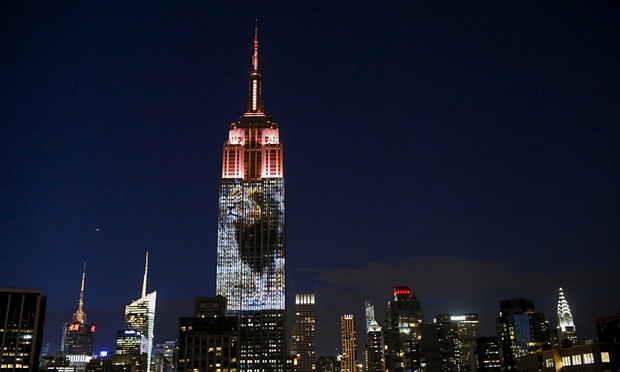Lindy West
The policeman who killed Michael Brown gets more sympathetic coverage than the dead teenager did, and let’s not even get started on Cecil the lion
Tuesday 4 August 2015
This past weekend, a massive photograph of Cecil the lion (the beloved animal whose illegal death at the hands of a dweeby American dentist inspired a global outpouring of grief) was projected on to the Empire State Building. The installation was part of a campaign to raise awareness about endangered animals – usually a fairly benign and uncontroversial cause (yes, alive lions good, dead lions bad) – that struck a sour, nearly satirical chord with many US activists. “I’m personally going to start wearing a lion costume when I leave my house so if I get shot, people will care,” writer Roxane Gay tweeted last week.
As many writers of colour have already pointed out, there has been no memorial on the side of the Empire State Building for the black American victims of police violence, let alone the black American victims of white supremacy in general. In fact, there has been no memorial on remotely that scale, or with that degree of civic endorsement. There has also been no unified international uproar demanding justice for those dead Americans, nor any swift legislation to make those Americans safer (by contrast, Congress is already working on a bill to ban big-game trophy hunting). I’m as disgusted as anyone by Great White Hunter vanity killing, but it is an objective fact that police officers hunting people is a more pressing social issue than dentists hunting lions. You can and should care about both, but caring about both requires caring about both.
Just a few days after Cecil’s face blazed above Fifth Avenue, the New Yorker published a lengthy profile of Darren Wilson, the former police officer who fatally shot black teenager Michael Brown (later testifying that he killed Brown because: “It looked like a demon”). The piece isn’t exactly laudatory, appearing to reveal Wilson as a paranoid racist who avoids “mixing-pot” areas, believes black people lack the “initiative” to get jobs, and describes inner-city children as “wild”. But it is long, and it is in the New Yorker, and it details Wilson’s personal and professional struggles with a modicum of reserved sympathy.
Michael Brown, meanwhile, received the venerable old-media treatment, too, in June of 2014, when – on the occasion of his burial – the New York Times described him as “no angel” who “dabbled in drugs and alcohol”. Michael Brown, the victim. Michael Brown, the dead teenager.
“Today, I read more about Darren Wilson’s ‘life’ than I’ve ever seen printed about any of the victims of the Charleston shooting,” Black Lives Matter leader DeRay McKesson wrote on Monday.
There is nothing intrinsically wrong with paying tribute to a big, beautiful lion whose life was sacrificed on the altar of white male insecurity. There is nothing intrinsically wrong, I suppose, with devoting column inches to an apparently dangerous racist publicly confirming that he is a dangerous racist. But we must remember that when we use the phrase “History is written by the victors”, we are talking about moments like this. This is what that looks like.
The victors (ie the beneficiaries of the status quo) are writing history, in front of our eyes, in real time – deciding what will endure and what will fade away. This isn’t necessarily an overt, explicit or even conscious process – it’s often just a series of seemingly innocuous choices that add up to a slow, grinding erasure. It’s re-centring Michael Brown’s story on Darren Wilson. It’s memorialising a dead lion on America’s most iconic building, while, in the city below, black people are fighting to simply be acknowledged as human beings (in a country built on black slave labour). It’s inviting a frothing misogynist on to provide a “counterpoint” every time a woman is interviewed about her bodily autonomy or her right to basic healthcare. It’s allowing David Brooks to write about Ta-Nehisi Coates.
History was so fiercely attached to the idea of Bill Cosby as “America’s dad” that it turned a blind eye to nearly half a century of sexual assault. When Rolling Stone’s now infamous campus rape expose fell apart in a maelstrom of journalistic negligence, it sparked a heated national conversation – not about the millions of rape victims around the world who still desperately need their stories heard and believed, but about the relatively minuscule number of false rape accusations. We could have chosen, as a public body, to keep digging, to keep honouring and supporting rape victims. Instead, we chose to bolster the very forces that keep most rapes unreported and unprosecuted. That’s the lesson America took away from Rolling Stone’s failure – not that the media needs to do a better job reporting on sexual assault, but that women are liars.
Eventually, these small choices accumulate into a near-unassailable mountain of blithe, mealy-mouthed scepticism and faux neutrality and “Well, we don’t know all the facts” and bigotry disguised as reason. It sandbags the tide of change. It gives regressive cowards something to hide behind, to justify staving off the discomfort of real progress for another month, another year, another generation. And it changes the way we remember our own past, even just five, 10 years down the line.
This is why diverse newsrooms matter. This is why representation matters. It matters which ideas are granted legitimacy by the New Yorker and the New York Times and the BBC and the Guardian. It matters that marginalised voices are so often relegated to more ephemeral forms of media, such as Twitter, where they’re vastly less searchable and relentlessly punished by trolls.
It all matters. And it’s your history, too, so pay attention.
© 2015 Guardian News and Media Limited. All rights reserved.
See online: Black American lives are being erased. The victors still rewrite history

